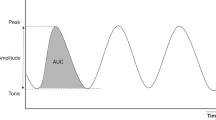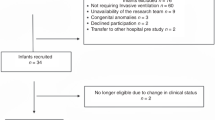Abstract
A full-term newborn infant is described with recurrent episodes of oxygen desaturation and apnea on the day of birth. The apnea did not improve with continuous positive airway pressure (CPAP) and intermittent nasal ventilation, therefore intubation and mechanical ventilation were required. A preliminary diagnosis of congenital central hypoventilation syndrome (CCHS) was made with the use of simultaneous measurements of end-tidal CO2 (EtCO2) and a diaphragm electrical activity waveform that was detected using microsensors placed on the infant’s feeding tube. It was observed that during deep sleep, the diaphragm electrical activity waveform was close to 0 μV (central apnea) and EtCO2 levels rose accordingly (central hypoventilation). Genetic testing subsequently revealed a Phox2b mutation, establishing the diagnosis of CCHS. Simultaneously measuring diaphragm electrical activity and EtCO2 is feasible and may be a valuable bedside diagnostic tool in cases of suspected CCHS before the diagnosis is confirmed with genetic testing.
This is a preview of subscription content, access via your institution
Access options
Subscribe to this journal
Receive 12 print issues and online access
$259.00 per year
only $21.58 per issue
Buy this article
- Purchase on Springer Link
- Instant access to full article PDF
Prices may be subject to local taxes which are calculated during checkout


Similar content being viewed by others
References
Weese-Mayer DE, Berry-Kravis EM, Ceccherini I, Keens TG, Loghmanee DA, Trang H ATS Congenital Central Hypoventilation Syndrome Subcommittee. An official ATS clinical policy statement: Congenital central hypoventilation syndrome: genetic basis, diagnosis, and management. Am J Respir Crit Care Med 2010; 181 (6): 626–644.
Beck J, Reilly M, Grasselli G, Qui H, Slutsky AS, Dunn MS, Sinderby CA . Characterization of neural breathing pattern in spontaneously breathing preterm infants. Pediatr Res 2011; 70: 607–613.
Stein H, Alosh H, Ethington P, White DB . Prospective crossover comparison between NAVA and pressure control ventilation in premature neonates less than 1500 grams. J Perinatol 2013; 33: 452–456.
Sinderby C, Beck J, Spahija J, Weinberg J, Grassino A . Voluntary activation of the human diaphragm in health and disease. J Appl Physiol 1998; 85: 2146–2158.
Rahmani A, Rehman NU, Chedid F . Neurally adjusted ventilatory assist (NAVA) mode as an adjunct diagnostic tool in congenital central hypoventilation syndrome. J Coll Physicians Surg Pak 2013; 23: 154–156.
Luo YM, Tang J, Jolley C, Steier J, Zhong NS, Moxham J, Polkey MI . Distinguishing obstructive from central sleep apnea events: diaphragm electromyogram and esophageal pressure compared. Chest 2009; 135: 1133–1141.
Kumar R, Macey PM, Woo MA, Harper RM . Rostral brain axonal injury in congenital central hypoventilation syndrome. J Neurosci Res 2010; 88: 2146–2154.
Macey PM, Moiyadi AS, Kumar R, Woo MA, Harper RM . Decreased cortical thickness in central hypoventilation syndrome. Cereb Cortex 2012; 22: 1728–1737.
Author information
Authors and Affiliations
Corresponding author
Ethics declarations
Competing interests
Dr Beck has made inventions related to neural control of mechanical ventilation that are patented. The license for these patents belongs to Maquet Critical Care. Future commercial uses of this technology may provide financial benefit to Dr Beck through royalties. Dr Beck owns 50% of Neurovent Research Inc (NVR). NVR is a research and development company that builds the equipment and catheters for research studies. NVR has a consulting agreement with Maquet Critical Care. The other authors declare no conflict of interest.
Rights and permissions
About this article
Cite this article
Szczapa, T., Beck, J., Migdal, M. et al. Monitoring diaphragm electrical activity and the detection of congenital central hypoventilation syndrome in a newborn. J Perinatol 33, 905–907 (2013). https://doi.org/10.1038/jp.2013.89
Received:
Accepted:
Published:
Issue Date:
DOI: https://doi.org/10.1038/jp.2013.89
Keywords
This article is cited by
-
Patient–ventilator asynchrony during conventional mechanical ventilation in children
Annals of Intensive Care (2017)
-
Evolution of inspiratory diaphragm activity in children over the course of the PICU stay
Intensive Care Medicine (2014)



